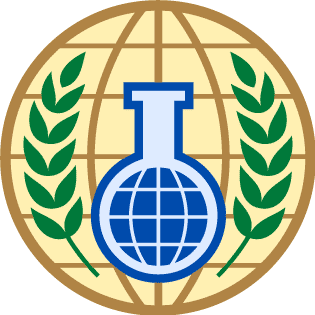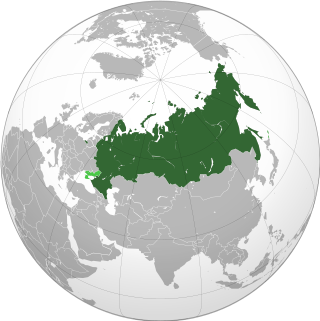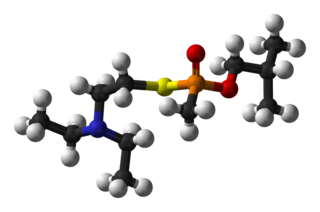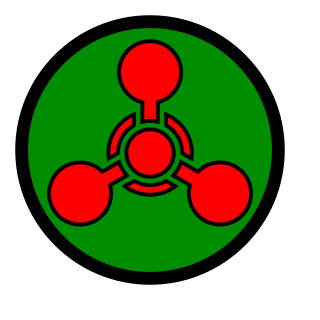Nerve agents, sometimes also called nerve gases, are a class of organic chemicals that disrupt the mechanisms by which nerves transfer messages to organs. The disruption is caused by the blocking of acetylcholinesterase (AChE), an enzyme that catalyzes the breakdown of acetylcholine, a neurotransmitter. Nerve agents are irreversible acetylcholinesterase inhibitors used as poison.

The Organisation for the Prohibition of Chemical Weapons (OPCW) is an intergovernmental organisation and the implementing body for the Chemical Weapons Convention (CWC), which entered into force on 29 April 1997. The OPCW, with its 193 member states, has its seat in The Hague, Netherlands; it oversees the global endeavour for the permanent and verifiable elimination of chemical weapons.

Chemical warfare (CW) involves using the toxic properties of chemical substances as weapons. This type of warfare is distinct from nuclear warfare, biological warfare and radiological warfare, which together make up CBRN, the military acronym for chemical, biological, radiological, and nuclear, all of which are considered "weapons of mass destruction" (WMDs), a term that contrasts with conventional weapons.

The Chemical Weapons Convention (CWC), officially the Convention on the Prohibition of the Development, Production, Stockpiling and Use of Chemical Weapons and on their Destruction, is an arms control treaty administered by the Organisation for the Prohibition of Chemical Weapons (OPCW), an intergovernmental organization based in The Hague, The Netherlands. The treaty entered into force on 29 April 1997. It prohibits the use of chemical weapons, and also prohibits large-scale development, production, stockpiling, or transfer of chemical weapons or their precursors, except for very limited purposes. The main obligation of member states under the convention is to effect this prohibition, as well as the destruction of all current chemical weapons. All destruction activities must take place under OPCW verification.
3-Quinuclidinyl benzilate (QNB) is an odorless and bitter-tasting military incapacitating agent. BZ is an antagonist of muscarinic acetylcholine receptors whose structure is the ester of benzilic acid with an alcohol derived from quinuclidine.

The Main Directorate of the General Staff of the Armed Forces of the Russian Federation, formerly the Main Intelligence Directorate, and still commonly known by its previous abbreviation GRU, is the foreign military intelligence agency of the General Staff of the Armed Forces of the Russian Federation. The GRU controls the military intelligence service and maintains its own special forces units.

The Russian Federation is known to possess or have possessed three types of weapons of mass destruction: nuclear weapons, biological weapons, and chemical weapons. It is one of the five nuclear-weapon states recognized under the Treaty on the Non-Proliferation of Nuclear Weapons and one of the four countries wielding a nuclear triad.

Many nations continue to research and/or stockpile chemical weapon agents despite numerous efforts to reduce or eliminate them. Most states have joined the Chemical Weapons Convention (CWC), which required the destruction of all chemical weapons by 2012. Twelve nations have declared chemical weapons production facilities and six nations have declared stockpiles of chemical weapons. All of the declared production facilities have been destroyed or converted for civilian use after the treaty went into force.
Novichok is a family of nerve agents, some of which are binary chemical weapons. The agents were developed at the GosNIIOKhT state chemical research institute by the Soviet Union and Russia between 1971 and 1993. Some Novichok agents are solids at standard temperature and pressure, while others are liquids. Dispersal of solid form agents is thought possible if in ultrafine powder state.

Shikhany, also spelled Shikhansky is a closed town in Saratov Oblast, Russia, 130 kilometers (81 mi) north of Saratov on the right bank of the Volga River Population: 6,067 (2010 Census); 6,738 (2002 Census); 12,763 (1989 Soviet census).. It has been a closed town since 1997, but lost this status on 1 January 2019. The town is 2 kilometres from the major chemical weapons base Shikhany-2.
The poison laboratory of the Soviet secret services, alternatively known as Laboratory 1, Laboratory 12, and Kamera, was a covert research-and-development facility of the Soviet secret police agencies. Prior to the dissolution of the Soviet Union, the laboratory manufactured and tested poisons, and was reportedly reactivated by the Russian government in the late 1990s.

Libya pursued programs to develop or acquire weapons of mass destruction from when Muammar Gaddafi seized control of Libya in 1969 until he announced on 19 December 2003 that Libya would voluntarily eliminate all materials, equipment and programs that could lead to internationally proscribed weapons. This included weapons of mass destruction and long-range ballistic missiles.

VR is a "V-series" unitary nerve agent closely related to the better-known VX nerve agent. It became a prototype for the series of Novichok agents. According to chemical weapons expert Jonathan Tucker, the first binary formulation developed under the Soviet Foliant program was used to make Substance 33, differing from VX only in the alkyl substituents on its nitrogen and oxygen atoms. "This weapon was given the code name Novichok."

A chemical weapon (CW) is a specialized munition that uses chemicals formulated to inflict death or harm on humans. According to the Organisation for the Prohibition of Chemical Weapons (OPCW), this can be any chemical compound intended as a weapon "or its precursor that can cause death, injury, temporary incapacitation or sensory irritation through its chemical action. Munitions or other delivery devices designed to deliver chemical weapons, whether filled or unfilled, are also considered weapons themselves."

The poisoning of Sergei and Yulia Skripal, also known as the Salisbury Poisonings, was a botched assassination attempt to poison Sergei Skripal, a former Russian military officer and double agent for the British intelligence agencies in the city of Salisbury, England on 4 March 2018. Sergei and his daughter, Yulia Skripal, were poisoned by means of a Novichok nerve agent. Both spent several weeks in hospital in a critical condition, before being discharged. A police officer, Nick Bailey, was also taken into intensive care after attending the incident, and was later discharged.

On 7 April 2018, a chemical warfare attack was launched by the forces of the government of Bashar al-Assad in the city of Douma, Syria. Medics and witnesses reported that it caused the deaths of between 40 and 50 people and injuries to possibly well over 100. The attack was attributed to the Syrian Army by rebel forces in Douma, and by the United States, British, and French governments. A two-year long investigation by the Organisation for the Prohibition of Chemical Weapons (OPCW) Investigation and Identification Team (IIT) concluded in January 2023 that the Syrian Air Force perpetrated the chemical attacks during its military campaign in Douma. On 14 April 2018, the United States, France and the United Kingdom carried out a series of military strikes against multiple government sites in Syria.
On 30 June 2018, in Amesbury, two British nationals, Charlie Rowley and Dawn Sturgess, were admitted to Salisbury District Hospital in Wiltshire, England. Police determined that they were poisoned by a Novichok nerve agent of the same kind used in the poisoning of Sergei and Yulia Skripal in Salisbury, 8 miles (13 km) away, almost four months prior. Sturgess died on 8 July, and Rowley regained consciousness two days later.

On 20 August 2020, Russian opposition leader and anti-corruption activist Alexei Navalny was poisoned with the Novichok nerve agent and as a result, he was hospitalized in serious condition. During a flight from Tomsk to Moscow, he became ill and was taken to a hospital in Omsk after an emergency landing there, and then, he was put in a coma. He was evacuated to the Charité hospital in Berlin, Germany, two days later. The use of the nerve agent was confirmed by five Organisation for the Prohibition of Chemical Weapons (OPCW) certified laboratories. On 7 September, doctors announced that they had taken Navalny out of the induced coma and that his condition had improved. He was discharged from the hospital on 22 September 2020. The OPCW said that a cholinesterase inhibitor from the Novichok group was found in Navalny's blood, urine, skin samples and his water bottle. At the same time, the OPCW report clarified that Navalny was poisoned with a new type of Novichok, which was not included in the list of controlled chemicals of the Chemical Weapons Convention.
The Insider is an online publication specializing in investigative journalism, fact-checking, and exposing fake news. It was founded by independent Russian journalist Roman Dobrokhotov. The publication operates websites in both Russian and English, along with a Telegram channel, an Instagram account, two TikTok accounts, and two YouTube channels: one for on-air programs and another for edited video content.
The Working Group on Syria, Propaganda and Media (SPM) is a controversial group of academics and activists whose stated purpose is to study propaganda and information operations surrounding the Syrian civil war. It was formed by environmental political theory professor Tim Hayward and former academic Piers Robinson in 2017.















